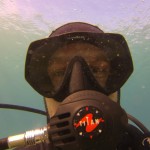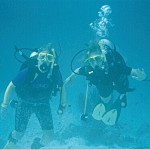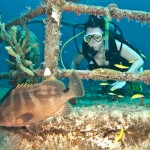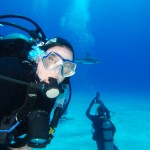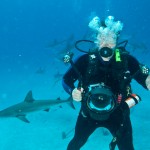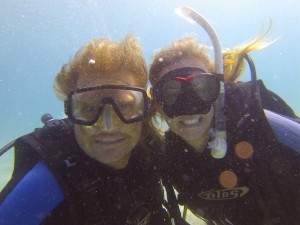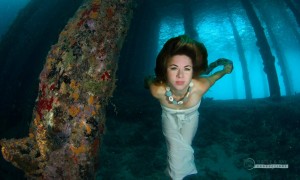This week I bought my first underwater camera, which is the GoPro Hero 3 with all kinds of assorted add-ons including filters and a macro lens (I didn’t know GoPros had macro lenses!). With my travels about to begin again, I sadly depart some beloved and talented dive buddies who have been so kind in sharing their incredible underwater photos on my website. I recognized the need for me to possess a scuba dive camera that will be suitable (and affordable) as a compact travel companion able to document in HD quality the wonders of the ocean in photo as well as video. That being said, although this is my first purchased camera, I do have some considerable exposure and experience to the art of underwater photography via my 1 year stint aboard the AquaCat scuba dive liveaboard in The Bahamas not to mention that photography class I took in high school (actually it helped a lot!).
Working on the liveaboard, I was responsible for shooting, editing, and displaying a photo CD for passengers to purchase. The vessel provided all of the equipment (Nikon D80 SLR camera along with Ikelite housing and strobes) and I had some valuable insights from the talents of Captain Ron McCaslin whose underwater photography experience extended from the pre-digital age when photographs were taken with film and developed on the boat during the weekly trips. How impressive! He’s the one that taught me to “avoid the wave” when taking photos of divers. Waving is great for video, but a no-no in underwater photography. I also had the opportunity to be advised by the super proficiency of Aleks Bartnicka who has been able to capture some of the most alluring and award-winning images I’ve seen to date. In addition to my own personal training, I also paid special attention to the intense photographic fanaticism from the passengers. At an average of 22 passengers each week over a year, that’s a lot of underwater photography lovers!
These days, virtually all scuba divers have entered into the realm of underwater photography. With the advances in technology, underwater photography has been made much more accessible and the ability to produce quality photos even by non-professionals is within reach. However, in spite of all this, the act of actually capturing those utterly illusive moments in nature is immensely challenging, highly addictive, and damn hard! And if you are successful in capturing that moment and also are able to somehow portray the marine animal as possessing human-like characteristics, well, that’s just…Magic!
But do you want to know what’s even more difficult than trying to capture that perfect fish portrait?
How about a bigger challenge or maybe you are interested in dipping your toe (fin?!) into unchartered waters? I would suggest you start taking some underwater photos of your scuba diver buddies!
I find it interesting that despite the fact that these days there are so many enthusiastic underwater photographers, there seems to be a lack of underwater photos of scuba divers. Even more so because who doesn’t want a photo of themselves doing such a cool thing like scuba diving?!
Thinking about my own personal experiences of taking photos of the passengers on the liveaboard and of attempting to be an underwater scuba diver super model, I can see two main reasons why scuba diver portraits are not in the mainstream of underwater photography.
First and foremost, it is virtually impossible to take an underwater “selfie”. Well, not impossible, but depending on your camera, it’s not as easy as on the surface to reach around and press “click”. Those buttons on underwater camera housings require a good and steady push in order to capture those magic underwater moments. My fingers don’t always bend that way.
I’d love to see your attempts at underwater “selfies” so please send me your snaps and I’ll post them on my Facebook page!
The other main reason I see as to why there isn’t an abundance of underwater scuba diver portraits lies in the fact that if we can’t take a selfie, we’ll need to get someone to take our picture for us. That means either convincing our dive buddy to devote his entire underwater time to being our personal photographer or hiring a professional. I’m not sure about you, but I don’t have a lot of scuba dive buddies who are interested in doing that!
While working on the liveaboard, I was aptly advised to take as many photos of the passengers themselves for exactly that reason. Finally these divers would be given the opportunity to possess photos of them while they keenly chased after turtles, rays, and colourful fish with their own cameras. And for me, well, I certainly had some…let’s just say “interesting” experiences that taught me a thing or two about underwater scuba diver portraits that may be of interest to you if you are venturing into this challenging avenue of photography.
It’s funny when you think about it for a moment, as a scuba diver diving underwater one can feel so…angelic…floating and feeling so effortless.
But as soon as you ask a diver to pose for a picture underwater all kinds of strange things happen!
Buoyancy – Gone. When you point a camera at a diver, they will most definitely float, sink, stir up dust, bump into overhangs. Suddenly they have no sense whatsoever of what their bodies are doing! I’ve seen it all.
Your best bet is to prep your underwater model before the dive. Tell them how you would like to see them and how you will communicate with them so that you can get the shot you are looking for. For example, I always want to take photos of scuba divers and a cool animal underwater. It’s so frustrating to have a scuba diver there looking at the animal and not taking a moment to look up and into the camera for that awesome waiting shot. The best positions for your underwater model will be in a horizontal pose, fins behind, all gear streamlined (i.e. nothing dangling) and either arms crossed or wide open depending on what you want to convey. Tell your underwater model to pay attention to their buoyancy during photo taking and to be aware of their body positioning. If you’ve mastered the art of positioning, you should then take it to the next level and ensure that with every scuba diver portrait there is a nice marine animal with him or her in the photo. Take a look at this awesome photo of myself in my early days of diving while on a scuba adventure in The Maldives. Can you say “Awkward”!!?? The next one is of a very talented diver who seemed to immediately strike some awkward pose as soon as the camera was pointed in his direction (wasn’t there a Friends episode about this with Chandler??!!). I’ve also included one of my favourite scuba diver portraits I took of the lovely Laura who enjoyed the groupers on The Austin Smith wreck in The Bahamas.
Facial expressions – Blank. The wonder and amazement that we express when we are out of the water often evaporate. It’s as if the diver feels the mask and regulator is hiding their face, but in fact the mask and eyes are what draw us into a solid scuba diver portrait! I once showed a non-diver friend some of my photos and he remarked, “Wow, those scuba dive masks sure don’t make a person look attractive, do they?” I beg to differ, but I could be biased in thinking that any piece of scuba dive equipment is sexy…
I always tell my divers to smile with their eyes and/or to think of something funny and it definitely makes a big difference. Tell your model to smile even with the regulator in their mouth because it will be reflected in their eyes. If the diver feels comfortable, they can even remove the regulator from their mouth for a nice natural smile, but be sure to advise the model to point the mouthpiece of the regulator down so bubbles don’t free-flow and ruin the photo. I also really think that scuba dive masks with the clear skirt make better facial portraits than the dark ones, but I think that’s just a matter of opinion. Look at the differences in these photos. The contentment in the eyes of Thiago on the left completely draws you into the photo whereas the blank stare from the woman on the right creates a stale, uninviting photo despite the excitement of the sharks!
Enter Mr/Mrs Bubble-Face. As we all know, the number one rule of scuba diving is to never hold your breath, but an awareness of your breathing is essential in underwater scuba diver portrait photography. And timing your breaths with the taking of a photo is vital to avoid the inevitable bubble-face syndrome! Again, just communicate with your underwater model prior to the dive and remind them to time their breathing. This photo of me was taken during my PADI Open Water Diver course in Guam and take a look at this funny photo of a scuba diver I took during a shark feed dive in The Bahamas. One breath of bubbles can make or break a photo!
Here Comes The Sun. This is the easiest mistake to fix and it’s the same on land so nothing really technical about this one. Simply an awareness of where the sun is will enable you to create a great photo even without strobes. The sun should always always always be at the photographer’s back. It’s helpful if your model also knows this simple rule, so that he/she may position themselves in the appropriate location. Take a look at this photo our dive guide took of Justin and me on Justin’s PADI Discover Scuba Diving experience on my latest trip to Mexico. Could have been a lovely portrait, but the light behind us created shadows right across the most important part of a scuba diver portrait – the eyes! I think we were too excited about his first dive to pay attention to where the sun was!
An underwater photo shoot to boot in Curacao!
Recently I had the opportunity to view some incredible photos by some former scuba dive colleagues of mine who are now working and living in Curacao. Leticia Duran and Arne Richter own and operate Turtle and Ray Productions over there and ran an incredible photo shoot with Erin R of A Munchkin Abroad. I really hope to see more of these types of photos from them in the future!
On that note, I look forward to seeing some new and improved underwater scuba diver portraits! I really do love those beautiful underwater creatures, but why not explore a new challenge and snap some shots of your buddy! Send me your favourite underwater scuba diver portraits! I want to see them!






